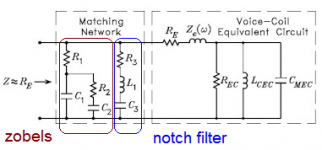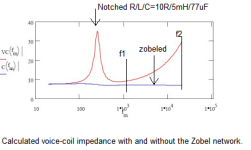You know, I really doubt that..........Who knows, a large percentage of the elder audiophiles could still be highly shaggable.

But compensating the impedance curve of my driver (1500 - 40 000) makes, for sure, a real positive difference.
I would concur, but surely this is a Thiele (parallel) rather than Zoebel (series) network? Or just call it a conjugate notch as Zaph used to, which removes all confusion?
The irony is that it's probably only IM and non-linear distortion in tweeters, when driven at say 15kHz, that most of us on this thread can hear. In the natural world, we probably can't distinguish any harmonic detail that would let us tell a sine from a square wave at even at8kHz, for example..........we shouldn't be able to tell them apart, if we can it is only because of unnatural cues. The better the playback system the less one should be able to distinguish stimulus that includes content beyond our audible threshold...........strange world eh ?But for evaluating tweeters, it might be a good idea you ask the young ones.
May-be you simply love to get more trebles ?
<snip>
If they make-you lose some needed treble, you will prefer without ;-)
Of course I knew I would get this response
And yes, without the zobel you will get a lot of "hash" or noise, mostly with bad recordings. I hate it myself. So I have tried to find the solution without using zobel.
The compensation networks I use are parallel, of course. And situated after passive crossovers if any.I would concur, but surely this is a Thiele (parallel) rather than Zoebel (series) network? Or just call it a conjugate notch as Zaph used to, which removes all confusion?
See: DIY Speakers Design Knowledge, Speaker Review, Loudspeaker: Zobel Network Design
Once achieved with a given transducer, I consider-it as part of the speaker, and will use-it even with active filter.
Of course, in order to save components, the inductance compensation can be mixed with the low pass filter by simply increasing the last // capacitance for bass or medium transducers.
How do-you expect phase is changed at the output of an amp with very low internal resistance by adding a little parallel charge ? It is a capacitance with a serial resistance.it's about phase.
The goal is dual. First, having flat impedance curve after the cable ensure any serial resistance in it will not have impact on the response curve. Second, as explained, ensure the amp will not have to deal with disparites between voltages an currents all along the audio bandwidth.
Last edited:
billshurv,
I think a more appropriate name is a tank circuit, LCR, that is of course a parallel shunt circuit to tame the impedance rise of the drivers in question.
I had a feeling from the description that Jay was talking about a series circuit, he made it sound like a low pass circuit rather than a shunt conjugate network, or tank circuit.
I think a more appropriate name is a tank circuit, LCR, that is of course a parallel shunt circuit to tame the impedance rise of the drivers in question.
I had a feeling from the description that Jay was talking about a series circuit, he made it sound like a low pass circuit rather than a shunt conjugate network, or tank circuit.
matching network, conjugate, tank, boucherot; anything but Zobel. It just confuses as people think that a Zobel is a series network, even tho it isn't really. Having checked Esperado is correct in his use of the term, even if most consider it to be something in the amplifier.
You can't have a democratic vote on physics.
Sure you can. Just that Mother Nature has the ballot box rigged.
se
I had a feeling from the description that Jay was talking about a series circuit, he made it sound like a low pass circuit rather than a shunt conjugate network, or tank circuit.
I was talking what Christophe is talking about
Attachments
Did-you tried IRL ? or did you make your opinion in a world where amps, speaker's cables, and serial coils in filters have 0 Ohms of impedance and resistance?These circuits have no impact if the amplifier has low enough Zout. You only need them as part of a crossover to keep things tidy.
I always wonder why the same who are chasing ppm distortion numbers can neglect things with two degrees of magnitude more influence because it is not a common practice.
Sorry to be disagreeable, but get out of your book, try-it, and report what you found.
All our amplifiers , by now, have "low enough Z out". Several members reported they had tried, and "Yes, it works". Do-you really suggest they are liars or fooling themselves?
Yes, it works, and, even using big diameter wires in the air coils of your passive filters, you can measure the difference in the response curve, and waterfalls. And, may-be it is just anecdotic, but it will really improve your listening pleasure, witch is the only goal.
The goal is dual. First, having flat impedance curve after the cable ensure any serial resistance in it will not have impact on the response curve. Second, as explained, ensure the amp will not have to deal with disparites between voltages an currents all along the audio bandwidth.
BTW, I know what my ears/brain like. What I don't know is, what has been the reason almost all high end speakers ignore this impedance flattening zobel [not the notch] when it looks/sounds so USEFUL, CHEAP and EASY to implement
Attachments
I may be wrong about this but I would think that as you flatten the impedance rise you are also straightening the phase wrapping with increasing frequency?
No, an amp with low Zout will keep the voltage constant regardless of whatever additional circuitry you may hang on the output. Therefore, the frequency response of the driver remains unchanged. Since the phase response of a minimum phase system is directly correlated with the frequency response, this also leaves the phase response unchanged.
Therefore, you only need these kind of compensation networks if you have a high Zout amp, or in order to keep your filter slopes where you want them.
For example, a resonance peak in your tweeter may upset your high pass network, so in that case you need to put in a zuigkring.
Do-you really suggest they are liars or fooling themselves?
Who am I to deny that people aren't constantly lying and fooling themselves?
You mention filters, and as I said, this is the exception. In order to get a filter to function, you sometimes need to compensate for driver impedance idiosyncrasies.
@vacuphile: https://www.passdiy.com/pdf/cs-amps-speakers.pdf care to comment on these plots of a REAL speaker being driven by a low Z voltage source? Ok 96dB full rangers are not for everyone, but here is a real case where a low Z-out will not give you pleasure unless you correct somewhere. An outlier for sure, but a real case.
Billshurv, in series corrections, for sure. Can be very useful and are often necessary, certainly on full range speakers. The Pass article is interesting for those contemplating the use of high Zout amps, or current source amps. Very different ballgame, but completely in line with what I said before.
Parallel correction networks just change the load on the amp, so only if the amp is sensitive to load fluctuations, it will make a difference. A true current source amp has the ultimate sensitivity to load changes, looking at voltage.
Parallel correction networks just change the load on the amp, so only if the amp is sensitive to load fluctuations, it will make a difference. A true current source amp has the ultimate sensitivity to load changes, looking at voltage.
Last edited:
Ok don't try.You mention filters, and as I said, this is the exception. In order to get a filter to function, you sometimes need to compensate for driver impedance idiosyncrasies.
Because i had tried-it, i can tell-you it makes a difference even with active filters, and amplifiers in the enclosure (lowZ cable, right ?).
Now, I'm sure that, with all your theoretical knowledge, (don't I have the same ?) you will find your explanation of the observed difference. PSU side ? Feedback side ?
As you will find a difference if you feed the amps of your multy-way active system with a single PSU or a separate PSU for each amp. And a difference (once you will have addressed the ground loop problems) between a single PSU for a stereo system and a double mono configuration, regarding stability of the instruments in the space.
Yes, hifi can sometimes rely on optimization of little details in our imperfect assemblies, and simulators don't enjoy the music ;-)
Oh, last remark, I don't sell anything, so I have no financial interest in anything here.
Last edited:
- Status
- Not open for further replies.
- Home
- Member Areas
- The Lounge
- John Curl's Blowtorch preamplifier part II

